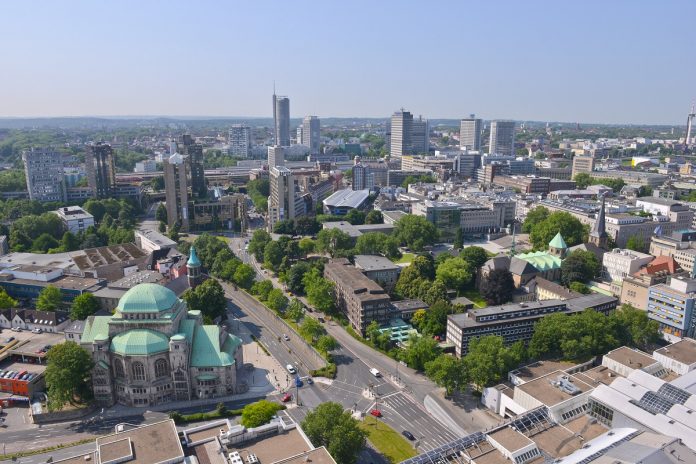Essen was granted the prestigious title of European Green Capital 2017. Lord Mayor Thomas Kufen highlights how the city became the third greenest in Germany
In June 18, 2015, the European Commission jury awarded the city of Essen the title of European Green Capital 2017. In particular, the effects of the structural change from a coal and steel city “to the third greenest city” in Germany were highlighted in the explanatory statement of the jury. This means that Essen plays a pioneering role for many cities in Europe that are now undergoing structural change. Essen’s vision of the future is that of a prospering, sustainable, liveable city that is resistant to climate change and offers its citizens a healthy environment. Essen promotes green infrastructure with high quality of air and water, parks with a great recreational value, an innovative and environmentally friendly (green) economy, integrative education and future-oriented mobility concepts. All of these aspects are part of the goals we want to achieve in the near future: a model split of 25% each by the year 2035 (25% public transport, 25% car traffic, 25% bicycle traffic, 25% pedestrian), reduction of CO2 output by 40% by 2020, and 20,000 green jobs by 2025, to name just a few examples.
Therefore the programme of the European Green Capital 2017 will address in total 12 “green” topics, from climate change, urban transport and air quality to waste generation, water management and energy efficiency. Our aim is to trigger sustainable processes and developments that will lastingly secure the quality of life in our city, or possibly even improve it further. In doing so, we will use existing synergies with regional projects of the Ruhr Metropolis, but also with project partners at national, European and international level.
Five key themes have been developed to prepare the content of our programme for this year, each involving a multitude of events, congresses, projects and activities:
- My paths: activities focusing on mobility aspects.
- My rivers: an exploration of the conversion of the Emscher system and of the project “ESSEN – New Ways to the Water”.
- My green spaces: green areas in the city, citizenship, resilience, sustainable forestry and transformation.
- My shopping: sustainable behaviour in daily life.
- My future: new jobs in the green economy, innovative developments and facets of environmental education.
The various projects, actions and events proposed as part of our Green Capital year are grouped under these headings.
Through and through green
One of the milestones of the year 2017 will undoubtedly be the conversion and restoration of Emscher. The river, straightened and strapped into a concrete bed, still transports the sewage from the northern Ruhr area, but from 2017 onwards this will become an underground canal, and the Emscher becomes a natural river again with clean water in a green landscape.
Not only the renaturation of streams, but also the former industrial areas, can already be found in Essen in many places. The 23-hectare Krupp Park, which was built on the grounds of the former Krupp cast iron works, is impressive. In the immediate vicinity of the ThyssenKrupp company center, which has been awarded the German Sustainable Building Association for its efficient energy supply concept, the use of sustainable technologies and building materials, as well as an energy-efficient heating and cooling concept.
Even a long-cherished wish of the Essenes is fulfilled, if in the popular recreation area around Lake Baldeneysee in the south of the city bathing in the Ruhr due to the now very good water quality becomes possible. The “Neues Wege zum Wasser” (cycle paths), signposted cycle routes have been developed throughout the city, mostly on former railway routes connecting the Emscher and the Ruhr Valley with three North-South connections. In the Essen area, the “Radschnellweg Ruhr” (RS1) has already become a reality in a section that will lead more than 100 km through the metropolis.
Park and greenery in the city
About 1,600 hectares of the Essen city area are used as parks. Essen’s oldest publicly accessible green area is the city garden. Today green spaces are spread over the entire city and offer visitors the opportunity to relax and make use of these green spaces which are on their doorstep.
The Grugapark Essen is one of the most beautiful and largest folk-districts in Europe, with its botanical garden, an animal park, a game and sports paradise, a health and spa offer, the numerous meadows, playgrounds and the concert arena. It originated from the Great Ruhr Garden Exhibition 1929.
Even on former industrial sites such as the Zollverein coal mine, which has been part of the UNESCO World Heritage Site since 2001, nature has recaptured vast areas, which can be discovered on the “Route of the Industries”.
The title “Green Capital of Europe 2017” puts the city of Essen in the European focus. Through the support of the European networks and EU funding, many planned measures for a viable and liveable city will be even better implemented in the future.
The main focus in 2017 will be on the citizens of Essen.
Our aim is to awaken the curiosity to deal with the green topics in our city, encourage residents to join in, and create the future of our city together.
Therefore our claim is: Green up your life.
Thomas Kufen
Lord Mayor
City of Essen











